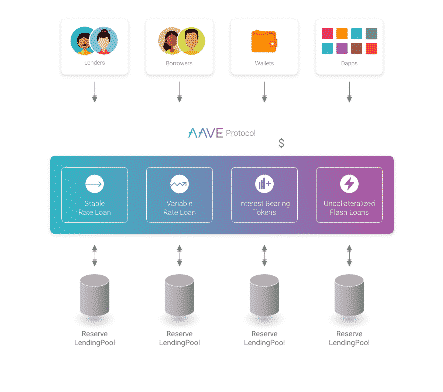Aave (LEND)
Last Updated on 6 November 2023 by CryptoTips.eu
The birth of Decentralized Finance (DeFi) has seen so many platforms joining the space. Unfortunately, it’s hard to differentiate genuine from phony platforms. Some have been shrouded in controversy while others are just forks (clones). Luckily, there are a few genuine ones that have continued to gain interest with time.
Aave protocol is one such platforms that is seriously driving the DeFi agenda to the next level. Here, we take a more in-depth look at the protocol, including its background, what it is, and a beginner’s guide how to get started with Aave.
- Aave
(AAVE) - Price $194.87
- Market Cap
$2.96 B

Aave (LEND)
More information
Background
 Aave means ghost in Finnish. According to its team, the name represents its vision to create a “transparent and open infrastructure for decentralized finance”. The Aave team comprises creative directors, risk managers, software engineers, digital marketers, tech evangelists, and other professionals with extensive experience in diverse fields. For example, the project’s CEO, Stani Kulechov, and its COO, Lazaro Gustave, have held roles in ETHLend.
Aave means ghost in Finnish. According to its team, the name represents its vision to create a “transparent and open infrastructure for decentralized finance”. The Aave team comprises creative directors, risk managers, software engineers, digital marketers, tech evangelists, and other professionals with extensive experience in diverse fields. For example, the project’s CEO, Stani Kulechov, and its COO, Lazaro Gustave, have held roles in ETHLend.
What is Aave?
Aave is a blockchain-based protocol powering a non-custodial money market that involves borrowers and lenders/depositors.
The network receives liquidity from depositors and allows borrowers to obtain loans using an undercollateralized or overcollateralized approach.

The protocol is inspired by ETHLend, a decentralized peer-to-peer lending platform. The network provides lending by creating a market. Apart from providing these services to DeFi enthusiasts, the Aave protocol also allows similar products to be built on top of its platform and powered by the Ethereum blockchain.
Aave protocol employs the use of pools where depositors deposit their cryptocurrency. However, the pools are divided according to the cryptocurrency deposited. Depositors then become lenders and earn an interest charged on borrowers. Using a pooled approach, borrowers borrow from a pool and not from an individual depositor, effectively evading the p2p model used by other decentralized platforms. Aave supports Tether (USDT), DAI, Ethereum (ETH), wrapped Bitcoin (WBTC), Yearn.Finance (YFI), and 14 other cryptocurrencies.
How to get started with Aave?
First of all, you need to decide if you want to lend your coins to earn an interest or if you want to borrow crypto. Both options require you to connect a web 3.0 wallet like Metamask, Ledger, MyEtherWallet or Coinbase wallet.
How to connect a web 3.0 wallet?
Metamask is a web 3.0 wallet Chrome extension for Firefox and Chrome. You need to use one of these two browsers to connect your wallet. Make sure you download the official extension from the official wallet, there are a lot of fake wallets around that will steal your coins.
- Install the browser extension from the official website and activate it.
- Create an account and create a backup of your backup phrase (offline!).
- You can use your generated Ethereum wallet, connect your existing ETH wallet with your private key or connect your Coinbase wallet.
- Transfer funds (Ethereum) to your chosen wallet.
You can also easily connect your Ledger or MyEtherWallet.
How to lend your tokens (deposit) and earn interest
You can visit the Aave app by visiting this link. Make sure that you connect of the supported wallets and you choose the right market.
Deposits on Aave can be accessed by visiting the Deposit section on its website. This provides you with a list of supported cryptocurrencies from which you choose your preferred coin and the amount to deposit. Behind every currency you can see an estimation of the (yearly) interest.

The interests are not fixed because they depend on prevailing market conditions. Interest paid to lenders is based on the borrowing rate and the utilization rate. Note that depositors earn a higher yield when the utilization rate is high. Also, depositors access a share of the flash loans’ fees at the rate of 0.063 percent of the flash loan volume (more on flash loans later).
Although deposits don’t attract a cap on the deposited amount, depositing meager amounts may not be logical because the transaction cost may exceed the rewards.
Aave has an interest-based token, aToken, focused on depositors. aToken has a ratio of 1:1 to the deposited token.
How to borrow crypto using Aave?
To borrow, visit Aave and head over to the Borrow section and choose the crypto and select the amount. Note that you need to deposit an asset that will act as the collateral. The collateral determines the amount you’re eligible to borrow. Apart from the collateral provided, the maximum amount can also be influenced by the available liquidity of the asset you want to borrow. Choose between variable or stable rate to finish the process.
The Aave steady rate is a short-term fixed rate with the option to re-align in the future depending on market changes. Aave’s variable rate, on the other hand, is calculated from the demand and supply rate on the protocol.
Loan repayment is made using the ‘repay’ option on the borrowing part of the Aave dashboard.
Liquidation in Aave
Liquidation happens when the borrower’s collateral value significantly drops and does not effectively cover the loan or the remaining part of their debt. Two scenarios can ignite this. The value of the collateral can fall, or the value of the borrowed debt rises, leaving part of it exposed.
The Aave protocol has different liquidation penalties depending on the collateral type. Liquidations can be avoided by providing more collateral or repaying sections of a loan. Note that liquidators receive a liquidation bonus.
Aave flash loans
Flash loans are loans taken by Aave developers without collateral to build smart contracts. However, the contracts have to be geared towards loans. On getting the contract ready, proceeds from the product are used to repay the loan plus interest. End-users can access flash loans using applications such as defisaver and collateralswap.
How Aave handles governance
The second version of Aave introduced the AAVE token that supports staking. An individual can stake the token or delegate to what Aave calls ‘Protocol Politicians.’ Delegated tokens can be withdrawn at any time.
The politicians represent their people, those who have delegated the coins to them, on governance matters. The Aave network allows governance-related messages to be signed from the cold storage to reduce the need to transfer tokens from cold wallets to hot wallets.
Aave token (LEND), AAVE, and staking
The Aave protocol has a native currency called LEND. Sometimes called ETHLend (the old name), the token has a total supply of 1,299,999,942 tokens. LEND is developed using Ethereum’s ERC-20 standards. Aave’s native coin is used to receive discounts on transaction fees. Also, LEND investors receive a share of the platform’s transaction fees for securing the platform.
As with native token’s on other decentralized finance platforms, LEND provides voting rights on governance issues initiated through Aave improvement proposals (AIPs). Voters can use their tokens even if they are used as collateral.

The platform’s LEND tokens can be exchanged with the platform’s version two tokens, AAVE, at a ratio of 100:1 (Lend: AAVE). AAVE tokens can be staked in the Safety Module to earn Safety rewards. The Safety Module mitigates against a shortfall event. In case it happens, 30 percent of staked tokens are used to cover the deficit. Safety rewards are capped at 400 AAVE’s per 24 hours.
Conclusion
The Aave protocol is among the leading DeFi networks in the cryptocurrency world. On August 14, 2020, the platform was upgraded to version two. The new version brought advantages such as fixed-rate deposit, enhanced stable borrow rate, private markets, and gas optimizations.
The continued development of DeFi systems is projected to increase with some working to interface centralized finance (CeFi) with DeFi to ignite massive adoption.
Navigation